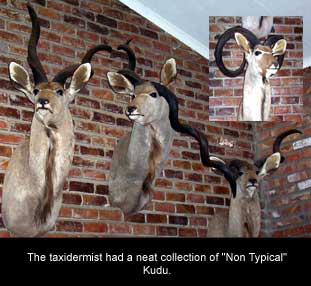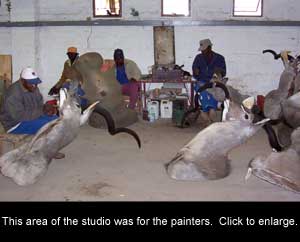Bowsite.com
The Nation's Leading Bowhunting Website
 |
|
|
Today I find out if I'll be hunting leopard or just plains game. After a morning of getting my bow rest fixed and my bow tuned, Dries and I had a quick breakfast and headed out for the capitol of the Northern Province; Pietersburg (now called Polokwane). The ride took over 3 hours (one way) but that didn't bother me. It was neat to see more of South Africa, the cultures and the landscapes. As we got within 30 miles of Pietersburg, the Waterburg Mountains dotted the horizon. These rock formations were not what I would have expected in South Africa and were remarkable. While entering the mountains Dries drove past a sign warning about the road being closed. I thought nothing of it until we approached a bridge. Something didn't look quite right about this bridge. I asked Dries: "Is that bridge leaning?" "Yes, the rains have eroded the ground around the bridge and the bridge has become disconnected from the land on the lower side.
"Well, isn't that comforting" I thought as Dries drove by the huge cracks in the pavement and took the 'uphill' side of leaning bridge - the side where the lane still had contiguous pavement. This wasn't a small bridge either; it was a big cement bridge over a 300' gorge. I was not fearful for my life or anything dramatic like that - it was just creepy to be riding over it. We put the "bridge of death" behind us and headed down into Pietersburg. After a short stop for some shopping we reached the ministers office and two hours later we were driving away with my permit. For me, the process was relatively painless - assuming you consider flying 8,000 miles to find out - "painless". In actuality, the painful part of this was done by Dries ahead of time. His father, Dries Sr. and even Gene Wensel all took part in the effort to obtain my permit. And I was thankful for their efforts. Leopard permits are not easy to obtain. On the way back out of town we drove back over that horrible bridge again. Only this time there were police vehicles and a wrecker backed up to the guardrails. We stopped and got out of our truck to see what had happened. Sometime after we had passed over this bridge a pickup truck had gone over the guardrails and crashed on the banks within the gorge. I could not see any bodies, but there were no survivors. The pickup was folded in half and was unrecognizable.
Before heading home Dries needed to pick up a buffalo hide and skull from a taxidermy operation. The owner was gracious and gave me a tour of his facility. It was huge! And he had several different areas of a 100k Sq. foot facility working different processes. He had a skinning shed, a form shed, a quarantine, a finishing/painting area and the showroom. In the showroom he had a collection of "freak" kudus. It was quite the operation.
We got home that evening and joined the other hunters for dinner in the main lodge. No shooting tonight, I still needed to practice on my own a little bit more in the daylight. Tomorrow we'd check the baits again and maybe sit a waterhole for part of the day. With the permit stuff behind me the only thing I need to focus on is my shooting - then it was the waiting game until the right leopard hits the bait.
|
 |









